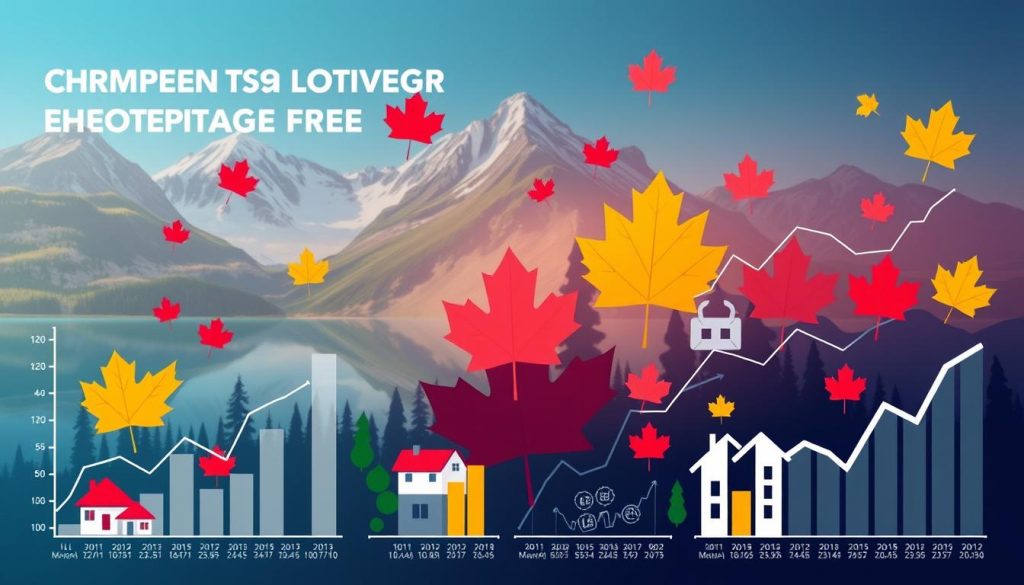As a homebuyer in 2024, I’m looking for the best mortgage rates in Canada. The financial world is always changing, making it key to find low interest mortgages. The five-year fixed mortgage rate has dropped to 3.94%, thanks to bond yields falling to 2.7%.
This is a great chance for me to compare mortgage rates. Banks like Meridian Credit Union and Canwise are offering better rates. Getting pre-approved can lock in rates for up to 120 days, protecting me from market changes.
The recent GDP reports have made finding a low interest mortgage more exciting. True North Mortgage is a trusted advisor with over $20 billion in mortgages. They offer better rates than banks and have a Rate Relief® product for budget help.
They also give up some of their commission to help clients. This makes them a great choice for me.
Key Takeaways
- Seek pre-approval to lock in the lowest five-year fixed mortgage rate for up to 120 days.
- Monitor bond yields and GDP reports, as they significantly influence mortgage rates.
- Engage with reputable lenders like True North Mortgage known for superior client savings.
- Evaluate the Rate Relief® product for added budget flexibility during the initial mortgage period.
- Understand that fixed mortgage rates provide stability amid volatile market conditions.
- Consider all rate types and latest market trends when deciding on your mortgage.
The Current State of Mortgage Rates in Canada

Understanding mortgage rates is key in today’s financial world. It helps decide if it’s the right time to buy a home or refinance. We’ll look at the latest trends, focusing on the lowest 5-year fixed mortgage rate, competitive rates, and the lowest variable rate in Canada.
Understanding the 5-Year Fixed Mortgage Rate Drop
The lowest 5-year fixed mortgage rate has dropped to just over 4%. This change is due to economic factors like falling bond yields. These rates are good for those looking to buy a home, offering stability against future rate hikes.
Factors Driving the Recent Decrease in Variable Mortgage Rates
Variable mortgage rates have also fallen, with some rates as low as 5.3%. This drop is thanks to the Bank of Canada’s rate cuts. These changes make borrowing more affordable, especially for those who like the flexibility of variable rates.
Insights on Prime Rate Fluctuations and Borrower Impact
The prime rate is now 6.45% at most banks, except TD Bank at 6.70%. Although higher than some past lows, these rates are still good for borrowing. Keeping an eye on these rates is important for making smart financial decisions.
Shopping for Canada’s Lowest Mortgage Rates
As someone deeply invested in the journey of homeownership, I recognize the importance of finding the best mortgage rates Canada offers. I use comprehensive mortgage rate comparison tools on platforms like Ratehub.ca. These tools show rates from the top mortgage lenders Canada hosts, including big banks and credit unions.
Understanding the differences between fixed and variable rates is key. The Bank of Canada’s rate cut has made variable rates more appealing. Early September 2024 saw fixed mortgage rates slightly drop, influenced by the government bond market.
Today, three-year fixed mortgages average below 4.5%, and five-year options are under 4.25%. These rates are lower than before. For example, in 2021, the average lending rate was around 3.28%, but it hit 7.18% in 2001.
Talking to brokers has shown that they can get variable rates down to about 5.25%. This is lower than the 5.9% banks offer. This highlights the importance of comparing offers carefully.
For me, the Bank of Canada’s rate decisions and bond yields are key. Each basis point cut in the BoC’s overnight rate lowers borrowing costs. Keeping up with these trends is crucial for good mortgage terms.
Understanding loan-to-value ratios, credit scores, and debt service ratios is also important. A credit score above 680 means lenders see less risk, which can lead to better rates. A larger down payment also reduces the loan amount and interest rates.
With new government incentives and better comparison tools, now is a great time to find low rates. The aim is to make sure my financial commitments align with my lifestyle and homeownership goals.
Securing the Lowest 5-Year Fixed Mortgage Rate
Finding the lowest 5-year fixed mortgage rate can be tough but doable. Knowing the latest trends and what lenders do helps us get great rates. These rates can really help our finances in the long run.
Exploring Your Options with Canadian Lenders
With rates as low as 3.94%, now is a good time to talk to different lenders. They might be more willing to offer good deals to attract customers. Places like Meridian Credit Union could have even better rates.
The Role of Bond Yields in Fixed Mortgage Rate Trends
Bond yields have fallen to about 2.7%, which has lowered 5-year fixed mortgage rates. These rates follow bond yields closely. This tells us what might happen to rates in the future.
Tips for Getting a Pre-Approval and Locking in Your Rate
Getting a pre-approval can lock in a rate for up to 120 days. Use a mortgage rate calculator to see how different rates affect your budget. This helps you pick the best rate available in Canada.
The table below shows how 5-year fixed mortgage rates have dropped over time. This is good news for today’s homebuyers:
| Year | Lowest 5-Year Fixed Mortgage Rate |
|---|---|
| 1982 | 16% |
| 1992 | 9.25% |
| 2002 | 6.7% |
| 2012 | 5.24% |
| 2022 | 6.49% |
| 2024 (Current) | 3.94% |
The rates have gone down over the years, showing how the economy changes. It’s key for homebuyers to keep up with rates and use tools like mortgage rate calculators. This way, we can make smart financial choices.
Navigating Variable Mortgage Rates in a Volatile Market
The Canadian housing market is always changing, and so are the variable mortgage rates. Finding the lowest variable mortgage rate can feel like trying to find your way in a maze. These rates change often, making it hard to know what to do.
Prime -0.90% to Prime -1.15%: Essential Considerations
The prime rate changes affect the competitive mortgage rates lenders offer. Rates now range from prime -0.90% to prime -1.15%. This small difference can greatly affect your monthly payments. It’s important to compare rates carefully before choosing.
The Bank of Canada has recently changed the prime rate. This shows how the economy is adjusting. It’s a good idea to keep an eye on these changes.
How Rate Holds and Prepayments Can Benefit You
Rate holds and prepayments can save you money in the long run. Rate holds lock in a rate for a while, protecting you from rate increases. Prepayments let you pay off your mortgage faster, saving you thousands in interest.
With the chance to prepay up to 20% each year without penalty, these options are very useful. They help you manage your finances better, especially in uncertain times.
Let’s look at how different rates affect your mortgage over time:
| Year | Variable Rate (%) | Fixed Rate – 5 Year (%) | Prime Rate (%) |
|---|---|---|---|
| 2021 | 1.95 | 2.60 | 2.45 |
| 2022 | 2.25 | 3.85 | 2.70 |
| 2023 | 3.50 | 4.25 | 3.95 |
| 2024 Forecast | 2.75 | 3.50 | 3.25 |
In conclusion, the world of mortgage rates, especially variable ones, is always changing. It’s important to stay alert and plan carefully. By doing so, you can find the lowest variable mortgage rate and make the most of your mortgage options.
Comparing Mortgage Rates: Banks Versus Credit Unions
When I help friends or family find the best mortgage rates Canada offers, I always say it’s key to compare rates. You need to look at what banks and credit unions offer. Their rates can really affect your finances over time.
Banks are known for being stable and offering a wide range of services. They are among the top mortgage lenders Canada has. But, credit unions like Meridian or Kindred offer personalized service and sometimes lower rates because they’re not-for-profit.
Let’s look at how picking a bank or credit union can change your mortgage:
- Banks: They offer a big network and stability but might have higher rates and stricter rules.
- Credit Unions: They focus on customers and often have lower rates. They might also be more flexible with credit scores.
| Lender Type | Typical Interest Rate | Flexibility | Service Model |
|---|---|---|---|
| Banks (e.g., RBC Royal Bank, TD Canada Trust) | Higher | Lower | Standardized |
| Credit Unions (e.g., Meridian, Kindred) | Lower | Higher | Personalized |
Choosing between a bank and a credit union can greatly impact your mortgage costs. It’s about matching your financial needs with what they offer. Always compare both options carefully to get the best mortgage rates Canada can offer, tailored to your needs.
Low Interest Mortgage Strategies for Homebuyers in 2024
Understanding low interest mortgages is key for Canadian homebuyers. The Bank of Canada’s rates are changing. This makes planning very important.
Utilizing Mortgage Rate Calculators for Best Results
Mortgage rate calculators are very helpful. They let you compare rates and see how they affect your payments. With rates possibly dropping to 3% soon, using these tools can save you a lot.
Engaging with Top Mortgage Lenders for Competitive Offers
Lenders want to keep clients with good rates. This means they offer great deals. Working with top lenders and brokers can help you get the best rates. For example, Altrua Financial can offer special advice and discounts.
In summary, the mortgage market looks good for 2024. But, homebuyers need a solid plan. Using mortgage calculators and working with the best lenders are key steps to getting great deals.
| Current Rate | Forecast Oct 2024 | Forecast Sep 2025 |
|---|---|---|
| Bank of Canada Prime Rate | 4% | 2.75% |
| 5-Year Fixed Mortgage Rate | 4% | 3.50%* |
| Variable Mortgage Rate | 5.2% | 3.50% |
*Projected decrease
Making Sense of the Rate Relief Products in Canada’s Market
In Canada’s changing financial world, knowing about mortgage rate comparison and Rate Relief products is key. This is especially true with recent economic changes and bank rate adjustments. The Bank of Canada’s rate cut has affected many financial areas, leading to new mortgage options for consumers.
Optimizing Your Budget with Short-Term Products
The Rate Relief product is a great choice for those in urgent need. It’s a six-month deal with a lower rate, helping with costs like closing expenses. It’s perfect for times when you need financial breathing room, allowing for better long-term planning.
How Flexible Mortgage Options Can Alleviate Financial Pressure
Companies like True North Mortgage lead the way with flexible mortgage options. They offer mortgages tailored to your financial situation, unlike traditional banks. This approach focuses on more than just rates; it’s about understanding your financial journey and helping you navigate it.
In summary, the Canadian mortgage market now offers solutions like Rate Relief and flexible mortgages. These options help meet different financial needs. By comparing mortgage rates, especially after recent cuts, you can improve your financial situation.
| Feature | Traditional Mortgage | Rate Relief Product |
|---|---|---|
| Term Length | 5-10 years | 6 months |
| Interest Rate | Variable, typically higher | Lower, fixed for short term |
| Flexibility | Low | High – suitable for immediate financial needs |
| Suitability | Long-term stability | Short-term financial relief |
Mortgage Prepayment Options and Their Long-term Benefits
Looking into mortgage prepayment options can really help your finances. It can save you a lot on interest. These choices are great for those looking for low interest mortgages in Canada.
There are many ways to manage your mortgage debt. Knowing these strategies can greatly improve your financial health. Options like paying more each month or making big payments can help you build equity faster and save on interest.
If you have a mortgage with the best rates in Canada, using prepayment options is even more beneficial. You can pay up to 20% of your mortgage balance each year without penalties. This is a great way to shorten your loan and save money.
| Prepayment Type | Annual Savings | Years Reduced |
|---|---|---|
| 10% Annual Prepayment | $28,350 | 4 Years |
| Biweekly Payments of $415 | $27,000 | 4.5 Years |
| Increased Monthly Payment to $1,000 | $48,000 | 8 Years |
| $10,000 Lump-Sum at Renewal | $37,481 | 6 Years |
The flexibility of mortgage prepayment options is why they’re so important. They help you achieve financial freedom sooner. Whether you have a low interest mortgage or the best rates in Canada, using these options can save you a lot and get you out of your mortgage early.
Expert Insights: Predictions for Mortgage Rate Trends in Canada
As we look ahead to 2024, it’s crucial to understand mortgage rate trends and the Bank of Canada monetary policy. This analysis aims to forecast the future of fixed and variable mortgage rates. We’ll also consider the broader economic markers.
Analysing the Bank of Canada’s Future Monetary Policies
The Bank of Canada aims to keep inflation at 2%. Their monetary policies will shape mortgage rates. From Q1 to Q4, rates might drop, showing a cautious optimism for economic growth and inflation control.
These policies will affect many areas, like consumer spending and the real estate market.
The Impact of Inflation on Future Mortgage Rates
Inflation is key in shaping monetary policy and mortgage rates. With inflation at 3.1% and a policy rate at 5.00%, rates might ease if inflation stabilizes. This could make borrowing costs slightly lower.
As inflation gets closer to the target, mortgage rate changes will become more predictable and favorable.
Here’s a quick look at predicted mortgage rate trends:
| Quarter | Predicted Rate Change |
|---|---|
| Q1 2024 | -0.10% |
| Q2 2024 | -0.15% |
| Q3 2024 | -0.20% |
| Q4 2024 | -0.25% |
This table shows a gradual decrease in interest rates. It also shows the Bank of Canada’s careful balance between economic growth and inflation control. Knowing these details helps borrowers make smart choices, especially when renewing their mortgages.
Conclusion: Making the Most of Canada’s Mortgage Opportunities
Canada’s mortgage scene is changing, thanks to the Bank of Canada’s rate adjustments. Now, homeowners and buyers can find some of the best mortgage rates in years. It’s key to see how these changes can help your financial plans.
Knowing the difference between fixed-rate and variable-rate mortgages is crucial. Lower interest rates can cut down your monthly payments. This could save you a lot of money over 25 years. So, it’s a great time to compare mortgage rates to get the best deal.
| Impact of Lower Interest Rates | Financial Benefits |
|---|---|
| Reduced Monthly Mortgage Payments | Potentially saves thousands over the loan’s term |
| Increased Demand in Housing Market | Makes properties more accessible to first-time buyers |
| Encouragement of Economic Activity | Stimulates spending and investment |
| Enhanced Homeownership Accessibility | Lowers the financial barrier for new entrants |
Canada’s top mortgage lenders are competing fiercely for borrowers. This competition means better deals for you, especially when rates are low. Now, more people can explore options like using home equity or locking in stable rates.
Thinking of switching from a variable to a fixed rate, or the other way around? Now might be the time. The world’s economic ups and downs can change mortgage rates. But, the current rates are lower, so it’s worth considering a switch. Talking to a mortgage expert can help find the best strategy for you.
To make the most of these opportunities, you need more than just rate knowledge. It’s about working with mortgage pros, using calculators, and watching the economy. This way, you can find the right mortgage for your future.
In summary, the current rate situation offers big benefits for refinancing and first-time buyers. By staying informed and proactive, Canadians can seize these chances. This way, they can secure a loan that’s not just a financial deal, but a solid investment for the future.
Essential Tips for First-Time Homebuyers Seeking Mortgages in 2024
As I explore the world of homeownership in 2024, I know finding the best mortgage rates Canada is key. For a first-time buyer, knowing your stuff is crucial. I start by checking out websites like ratehub.ca to compare mortgage offers from top mortgage lenders Canada.
Getting a good credit score, at least 680, is my first goal. I also aim for a 20% down payment to avoid extra mortgage insurance costs. This helps me get a better deal on my mortgage.
But the financial journey doesn’t stop there. I need to save for closing costs, which can be 3-5% of the home’s value. I also plan for maintenance, setting aside 2-5% of the home’s value each year. It’s all about balancing my debt service ratios and passing the stress test.
Understanding the difference between fixed and variable rates is important. I want a low interest mortgage that fits my budget. This way, I can handle any rate hikes that come my way.
Getting pre-approved is a big step towards owning a home. I’m looking at the pros and cons of different homes, like older ones that need repairs. I also consider longer mortgage terms for lower monthly payments.
Using financial tools like First Home Savings Accounts or the Home Buyers’ Plan helps me save. I keep up with the latest rules on who’s considered a first-time buyer. With a solid down payment and a clear budget, I’m ready to find my dream home.




